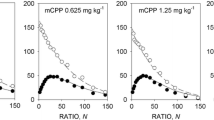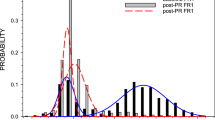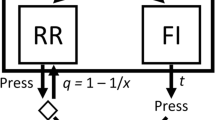Abstract
A quantitative behavioural test system based on Herrnstein's (1970) equation was used to test a prediction derived from the “anhedonia” hypothesis of neuroleptic action, that pimozide should increase the value of the behavioural parameter K H (the reinforcement frequency needed to maintain the half-maximal response rate in variable-interval schedules). On the basis of theoretical considerations, it was shown that the equation implies that a drug which exerts such an effect on K H must have a more profound suppressant effect on performance maintained by low reinforcement frequencies than on performance maintained by high reinforcement frequencies. Fifteen rats were trained under variable-interval 10-s and variable-interval 100-s schedules, and the effect of pimozide (0.125, 0.25, 0.33, and 0.5 mg/kg) was tested on performance maintained under each schedule. The drug suppressed performance maintained under both schedules in a dose-dependent manner, and there was no tendency for the drug to exert a greater effect on performance maintained under the lower reinforcement frequency. These results do not provide any evidence that the effect of pimozide on variable-interval performance is due to an “anti-hedonic effect”; rather, they are compatible with the hypothesis that pimozide impairs the capacity to respond.
Similar content being viewed by others
References
Ahlenius S (1979) An analysis of behavioral effects produced by drug-induced changes of dopaminergic neurotransmission in the brain. Scand J Psychol 20:59–64
Beninger RJ (1983) The role of dopamine in locomotor activity and learning. Brain Res Revs 6:173–196
Bradshaw CM (1977) Suppression of response rates in variable-interval schedules by a concurrent schedule of reinforcement. Br J Psychol 68:473–480
Bradshaw CM, Ruddle HV, Szabadi E (1981a) Relationship between response rate and reinforcement frequency in variable-interval schedules: II. Effect of the volume of sucrose reinforcement. J Exp Anal Behav 35:263–269
Bradshaw CM, Ruddle HV, Szabadi E (1981b) Relationship between response rate and reinforcement frequency in variable-interval schedules: III. Effect of d-amphetamine. J Exp Anal Behav 36:29–39
Bradshaw CM, Szabadi E, Bevan P (1976) Behavior of humans in variable-interval schedules of reinforcement. J Exp Anal Behav 26:135–141
Bradshaw CM, Szabadi E, Bevan P (1978) Effect of variable-interval punishment on the behavior of humans in variable-interval schedules of monetary reinforcement. J Exp Anal Behav 29:161–166
Bradshaw CM, Szabadi E, Ruddle HV (1983a) Herrnstein's equation: Effect of response-force requirement on performance in variable-interval schedules. Behav Anal Lett 3:93–100
Bradshaw CM, Szabadi E, Ruddle HV, Pears E (1983b) Herrnstein's equation: Effect of deprivation level on performance in variable-interval schedules. Behav Anal Lett 3:267–273
Catania AC, Reynolds GS (1968) A quantitative analysis of the responding maintained by interval schedules of reinforcement. J Exp Anal Behav 11:327–383
de Villiers PA, Herrnstein RJ (1976) Toward a law of response strength. Psychol Bull 83:1131–1153
Edmonds D, Gallistel CR (1974) Parametric analysis of brain stimulation reward in the rat. III: The effect of performance variables on the reward summation function. J Comp Physiol Psychol 87:876–884
Ettenberg A, Koob GF, Bloom FE (1981) Response artifact in the measurement of neuroleptic-induced anhedonia. Science 209:357–359
Fibiger HC, Carter DA, Philips AG (1976) Decreased intercranial self-stimulation after neuroleptic or 6-hydroxydopamine: Evidence for mediation by motor deficits rather than by reduced reward. Psychopharmacology 47:21–27
Gallistel CR, Karras D (1984) Pimozide and amphetamine have opposing effects on the reward summation function. Pharmacol Biochem Behav 20:73–77
Gray T, Wise RA (1980) Effects of pimozide on lever-pressing behavior maintained on an intermittent reinforcement schedule. Pharmacol Biochem Behav 12:931–935
Herrnstein RJ (1970) On the law of effect. J Exp Anal Behav 13:243–266
Herrnstein RJ (1974) Formal properties of the matching law. J Exp Anal Behav 21:159–164
Heyman GM (1983) A parametric evaluation of the hedonic and motoric effects of drugs: Pimozide and amphetamine. J Exp Anal Behav 40:113–122
Mason ST, Beninger RJ, Fibiger HC, Phillips AG (1980) Pimozide-induced suppression of responding: evidence against a block of food reward. Pharmacol Biochem Behav 12:917–923
Pinder RM, Brogden RM, Sawyer PR, Speight TM, Spencer R, Avery GS (1976) Pimozide: A review of its pharmacological properties and therapeutic uses in psychiatry. Drugs 12:1–40
Rolls ET, Rolls BJ, Kelly PH, Shaw SG, Wood RJ, Dale RT (1974) The relative attenuation of self-stimulation, eating and drinking produced by dopamine-receptor blockade. Psychopharmacologia 38:219–230
Ruddle HV, Morley MJ, Bradshaw CM, Szabadi E (1984) The effect of pentobarbitone on variable-interval performance: analysis in terms of Herrnstein's equation. Psychopharmacology (in press)
Szabadi E, Bradshaw CM, Ruddle HW (1981) Reinforcement processes in affective illness: towards a quantitative analysis. In: Bradshaw CM, Szabadi E, Lowe CF (eds) Quantification of steady-state operant behaviour, Elsevier/North Holland, Amsterdam, pp 299–310
Wise RA (1978) Catecholamine theories of reward: a critical review. Brain Res 152:215–247
Wise RA (1982) Neuroleptics and operant behaviour: The anhedonia hypothesis. Behav Brain Sci 5:39–87
Wise RA, Spindler J, deWit H, Gerber GJ (1978) Neuroleptic-induced anhedonia in rats: Pimozide blocks reward quality of food. Science 201:262–264
Author information
Authors and Affiliations
Rights and permissions
About this article
Cite this article
Morley, M.J., Bradshaw, C.M. & Szabadi, E. The effect of pimozide on variable-interval performance: A test of the ‘anhedonia’ hypothesis of the mode of action of neuroleptics. Psychopharmacology 84, 531–536 (1984). https://doi.org/10.1007/BF00431461
Received:
Accepted:
Issue Date:
DOI: https://doi.org/10.1007/BF00431461




